Rethinking Spring with Native Plants
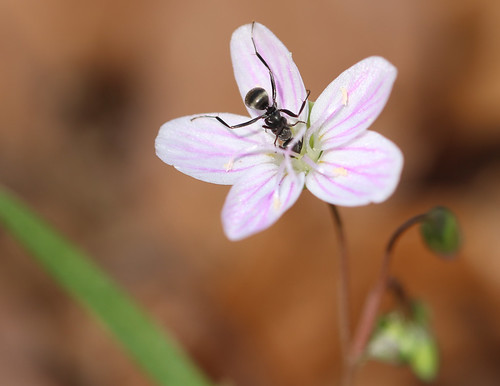
Spring beauty; by Kerry Wixted
This winter felt like it was almost endless. When the crocuses finally popped in my yard, I was ecstatic. For me, crocuses and daffodils have always been harbingers of spring, but these non-native plants in our landscapes offer little benefit for our native wildlife. There are many native plants, however, which co-evolved with our local wildlife. Below is a list of some early blooming plants that can be used to provide spring nectar and pollen resources.
Please keep in mind, to ensure the continued health of wild populations, get your seeds, corms and/or plant material from reliable nurseries. The Maryland Native Plant Society maintains a list of native plant nurseries.  Spring Beauty (Claytonia virginica)
Spring Beauty (Claytonia virginica) ![]()
![]()
![]()
![]()
Bloom: late March-June; delicate pink flowers with small stripes
Size: 4-6” tall and wide
Notes: To plant, sow seeds or plant corms in fall. The spring beauty bee (Andrena erigeniae) is a specialist pollinator of spring beauty. Many other small bees and flies will visit spring beauty blooms, some attracted to the nectar and others to the pollen. The corms are edible to people and to wildlife. Spring beauties will die back by June.
Bloodroot (Sanguinaria canadensis) ![]()
![]()
![]()
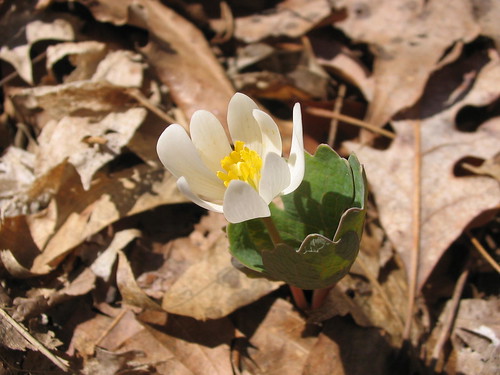
Bloodroot; by Kerry Wixted
Bloom: April-May; white flowers
Size: 6” tall and 6-10” wide
Notes: This plant is difficult to germinate from seed, so planting rhizomes is recommended. Plant rhizome pieces 1-2 inches under the soil. Be sure to only plant in moist, well drained and organic rich soil. Many bee species are attracted to bloodroot, including honeybees, bumblebees, sweat bees (Halictus spp., Lasioglossum spp.) and Andrenid bees (Andrena spp.) Other species such as beetles and flower flies are attracted to the pollen. Ants disperse the seeds. Like spring beauty, bloodroot will often die back by June but sometimes the leaves persist.
Common Blue Violet (Viola sororia) ![]()
![]()
![]()
![]()
![]()
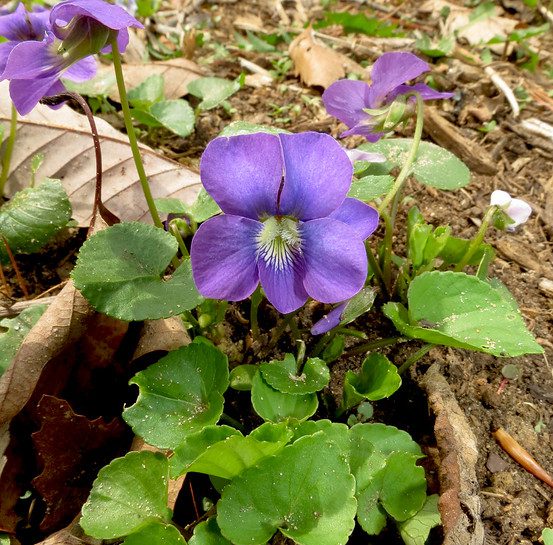
Common blue violet; by Kerry Wixted
Bloom: April-June; purple or white and purple striped flowers
Size: 6” tall and 6-10” wide
Notes: Common blue violet is often found growing naturally in backyards across Maryland. It has vigorous growth and will spread in full sun but doesn’t spread as fast in shade. These traits make it a great groundcover in some circumstances. The flowers aren’t too attractive to most insects, but the foliage is a host for fritillary butterflies. The horizontally branched rhizomes are easy to transplant just about anywhere. Lots of critters from groundhogs to rabbits will munch on violet leaves. The flowers are edible and can be candied for a spring treat.
Common Serviceberry (Amelanchier arborea)![]()
![]()
![]()
![]()
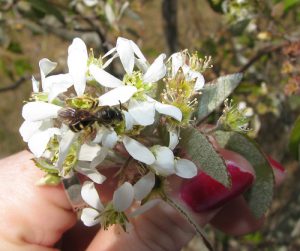
Common serviceberry; by Kerry Wixted
Bloom: late March-April; white flowers
Size: 15-25 ft tall and 15-25 ft wide
Notes: Serviceberry’s blooms were a signal of spring for European colonists. When the flowers bloomed, colonists could bury their dead that passed away during the winter, as the plant’s flowers indicated that the ground was no longer frozen. Its other name is shadbush, and as you may imagine, the blooms coincide with shad runs. Serviceberry can be found throughout much of Maryland aside from the lower Eastern Shore. It likes medium, well-drained soils and is relatively pest free. Deer, however, find this plant to be quite tasty, so it may not be the best selection if you have a high deer density in your backyard. Many early emerging bees are attracted to serviceberry, and butterflies like the red-spotted purple lay its eggs on the plant. The fruits are attractive to many bird species, including the Baltimore Oriole, and are even edible to humans too. It is best not to plant serviceberry near cedar trees as it is susceptible to cedar-apple rust.
Pussy Willow (Salix discolor) ![]()
![]()
![]()
![]()
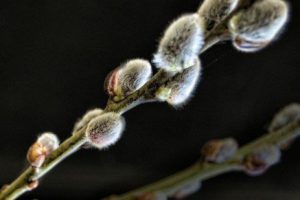
Pussy willow; by Teresa Alexander-Arab CC by ND 2.0
Bloom: March-April; fuzzy catkins appear before yellow flowers
Size: 15-25 ft tall and 12-25 ft wide
Notes: Though no longer found in the wild in Maryland, pussy willow is an important pollinator plant for many spring bee species. Plants exist as either males or females, so both sexes are needed for reproduction. The fuzzy covering is sometimes used by nesting hummingbirds. Both viceroy and mourning cloak butterflies will host on pussy willow. It can thrive in part sun conditions if kept wet and in warmer areas sections of Maryland such as the coastal plain. It is best to cut back the plant to allow for vigorous growth. Be aware that it will produce suckers if in the right wet conditions.
Red Maple (Acer rubrum) ![]()
![]()
![]()
![]()
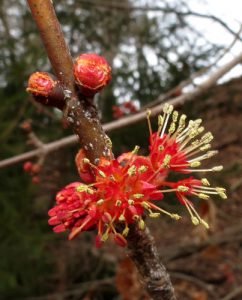
Red maple; by Kerry Wixted
Bloom: March-April; fuzzy catkins appear before yellow flowers
Size: 40-100 ft tall and 30-75 ft wide
Notes: Red maple is one of the most ubiquitous trees in Maryland forests. Its red flowers are often some of the first pops of color in early spring. Bees and the wind help pollinate this tree. If you suffer from seasonal allergies, this tree may not be the best pick for you. Red maples support multiple butterfly and moth caterpillars including showy species like the rosy maple moth and the cecropia moth. Like serviceberry, this tree is also favored by deer. Squirrels and birds will consume the helicopter-like seeds known as samaras which appear in late spring through June.
References:
Hilty, J. 2019. Illinois Wildflowers website. https://www.illinoiswildflowers.info/ Accessed April 4, 2019.
Slattery, B. E., K. Reshetiloff, and S. M. Zwicker. 2003. Native Plants for Wildlife Habitat and Conservation Landscaping: Chesapeake Bay Watershed. U.S. Fish & Wildlife Service, Chesapeake Bay Field Office, Annapolis, MD. 82 pp
Happy Spring HabiChat fans!
Spring has officially sprung in Maryland. The migratory birds, like warblers, are currently making their way through our forest. Early nesting bee species are emerging from their nests and are pollinating spring wildflowers. Young wildlife can be seen in the garden. I’m so excited for all of the spring phenomena at play!
In this edition of HabiChat, learn about our native spicebush and the beautiful lepidoptera it supports, as well as a little more information about our state bird, the Baltimore Oriole. This edition will also focus on ways to rethink spring by embracing some of our early flowering native plants. Finally, this HabiChat will introduce you to a couple of books that might be of interest for enhancing your backyard wildlife habitat.
Spring is such a busy time in our gardens. If you are interested in making your garden more pollinator friendly, check out the Spring 2015 HabiChat issue. In addition, keep in mind that young wildlife will begin to be a common sight in backyards. Last year’s Spring HabiChat focused on bird-safe windows and deer resistant plants for pollinators. Check out our page, Think Twice Before Rescuing Young Wildlife, to learn about best practices when it comes to young animals.
As a final note, the University of Maryland Extension is holding a General Forestry Course for Maryland landowners. The goal of the course is for the landowner to design a forest stewardship plan framework for their property. The course covers all aspects of forests and forest management. Registration opens June 1 and the course runs from Sept. 1 to Dec. 15. The cost is $150. For more information, please visit the University of Maryland Extension site.
Happy Habitats,
Kerry Wixted
Click here to have HabiChat—the quarterly backyard wildlife habitat newsletter from the Wild Acres program—delivered right to your inbox!
In this Issue
Native Animal Profile: Baltimore Oriole
Native Plant Profile: Spicebush
Habitat Tips: Rethinking Spring with Native Plants
Habitat Tips: Books for Backyard Wildlife Gardeners
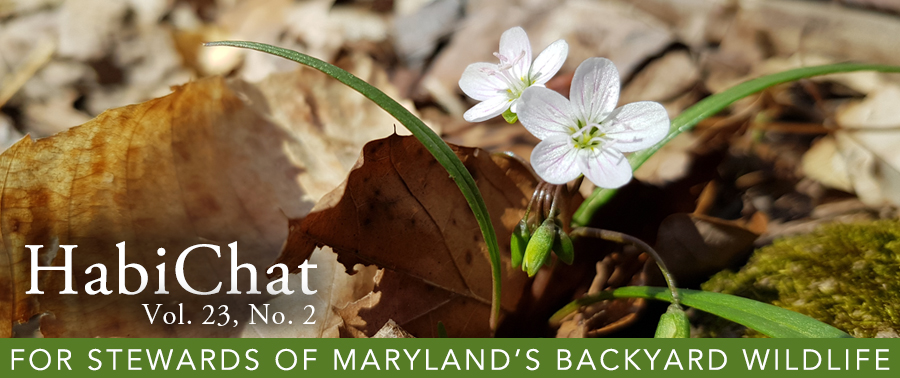

 1-888-373-7888
1-888-373-7888 233733
233733